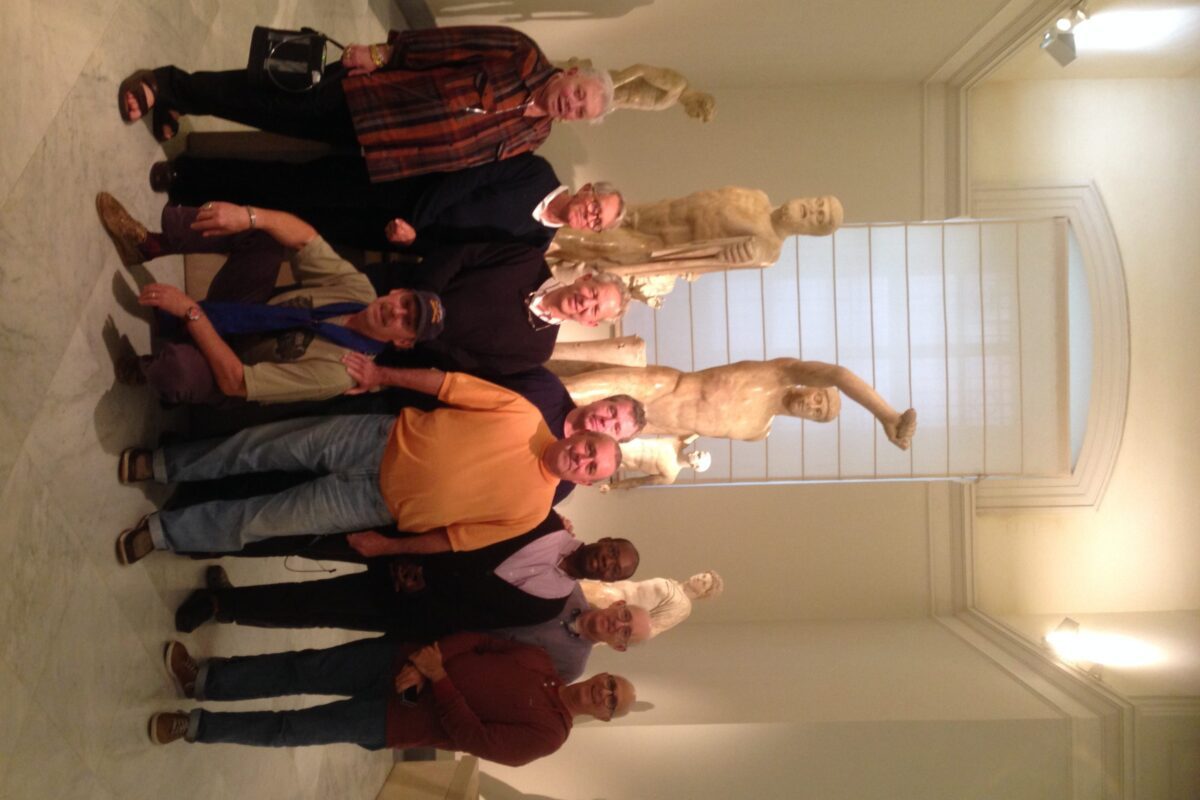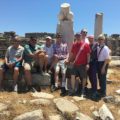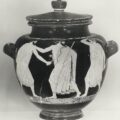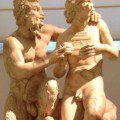Since I wrote my blog post last week about my gay history explorations, people have been asking me to say something more about gay history in Greece. And this is very much on my mind, as I am leading Oscar Wilde Tours’ gay history and art tour in Greece in only 3 or 4 months (https://www.oscarwildetours.com/gay-greece-travel-tours/)!
Greece is of course one of the great countries for gay history, because some form or forms of same-sex love were customary in the ancient Greek world. And lots of evidence remains—if you know where to look!
Gay Heroes of Athens
This stone is a great example. It’s a chunk of a statue base, in a glass case, in the Agora museum in Athens, and if you didn’t know what it was, you wouldn’t give it a second glance. But in fact, it speaks volumes about gay history in Greece. You can’t probably make it out in my lousy snapshot, but when it’s in front of you, you can clearly make out the upper line, which says (in Greek letters, but in this case, they’re close to the Roman letters we use), ARMODIO—most of the name HARMODIOS.
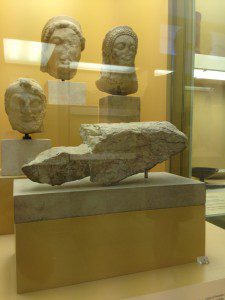
Harmodios and Aristogeiton statue base in the Agora museum
So…who was Harmodios? Well, he was the Athenian George Washington, or half of George Washington. He was the younger half of a typical Greek male-male lover-beloved couple, and he and his lover together assassinated the tyrant of Athens’ brother in 514 BC. So the Athenians (accurately or not) regarded them as the founders of the democracy. And they were hugely important in Athenian mythology. They were worshiped with blood sacrifice at their tomb. Their descendants had the right to eat free with the city council in perpetuity. And they were constantly praised in literature and art. In particular, they were the first mortal men honored with a public monument in the city of Athens. Indeed, so important was their monument that when it was carried off by the invading Persians in 490 BC, the Athenians put up a second one.
And this is a piece of its base. The monument is long gone, like most Greek bronzes—probably melted down in the middle Ages to make weapons. But we know what it looked like, because copies of it were popular in ancient Rome. There is a fairly complete marble copy in Italy, in the Naples archaeological museum, which I have used as the main photo for this post, with last year’s Oscar Wilde Tours Gay Italy group posed in front of it. So there they are, two of Greece’s favorite gay heroes. It’s pretty amazing that a piece of the original monument has survived to tell us about gay history in Greece!
Gay Gods at Olympia
Another things that that speaks to us about Greek ‘sexualities’ is this roof-ornament from the temple of Zeus Olympios at Olympia—the greatest temple of Zeus, in the sanctuary where the Greeks held their most important athletic competitions. Much as the Greeks had gay heroes, they also had gay gods, and the king of the gods (also of course a major womanizer) had a boyfriend, the Trojan prince Ganymede, whom he carried off to pour the gods’ nectar, “on account of his beauty,” as the Iliad says. And that is what this clay sculpture represents: Zeus carrying Ganymede off. It’s very different from the way the Greeks portray human love, which generally involves courtship, but Zeus is a god, so he doesn’t need all that folderol. This story appears a lot in Greek literature and art: poets say things like “of course I’m in love with a beautiful young man—Zeus did it too.” But it is really striking to a modern mind that it was represented on the roof of the most important temple of the king of the gods. This story wasn’t a joke for the Greeks, it was part of the top mythology of their religion, and here is the proof.
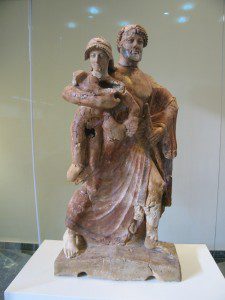
Zeus and Ganymede from Olympia
More Gay Gods at Delphi
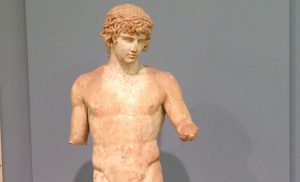
Antinous at Delphi
Another great gay artwork comes from Delphi, from the great temple of the ancient world’s most important oracle, where in response to questions from all over the world, the priests interpreted the inscrutable ravings Apollo supposedly inspired in his priestesses.
In Roman times, however, another god who was worshiped in this temple was Antinous, the lover of the Emperor Hadrian who was deified after he fell into the Nile at the age of 19 and drowned, possibly a suicide. Antinous became a quite popular god, and there were statues of him all over the empire.
This one must, however, have been particularly important, because, as you can see in the antique photo, he was
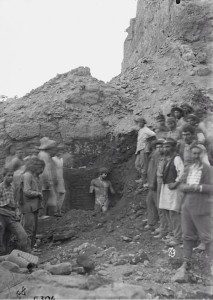
Discovery of Antinous at Delphi
rediscovered in 1894, still upright under the debris the temple. Since his broken arms among other things suggest that the statue was knocked down by the barbarians who destroyed the temple, this suggests that somebody cared so much about Antinous that they put the statue back up *after* the temple’s destruction. That is worship!
And what a good statue to worship! As always, Antinous has his fashion model looks: pouty lips, a distant stare, and his tousled but perfect hair. But somehow this is the most handsome of all the many statues of him, and a fitting monument to gay history in Greece—a culture in which the military heroes and gods were often what we would call gay!
Want to find out more? Join us for our Gay Greece trip, September 7-19! https://www.oscarwildetours.com/gay-greece-travel-tours/

